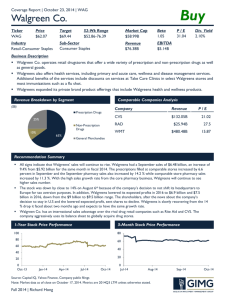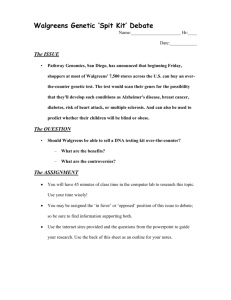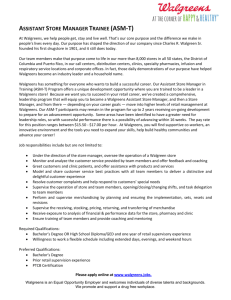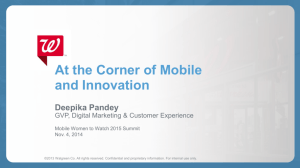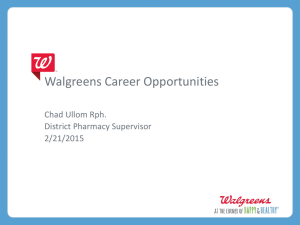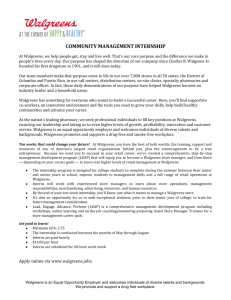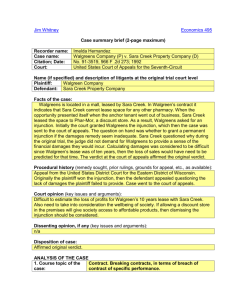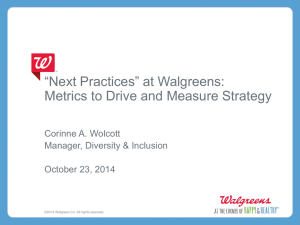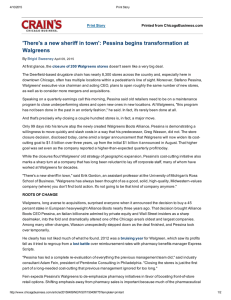Interview
advertisement
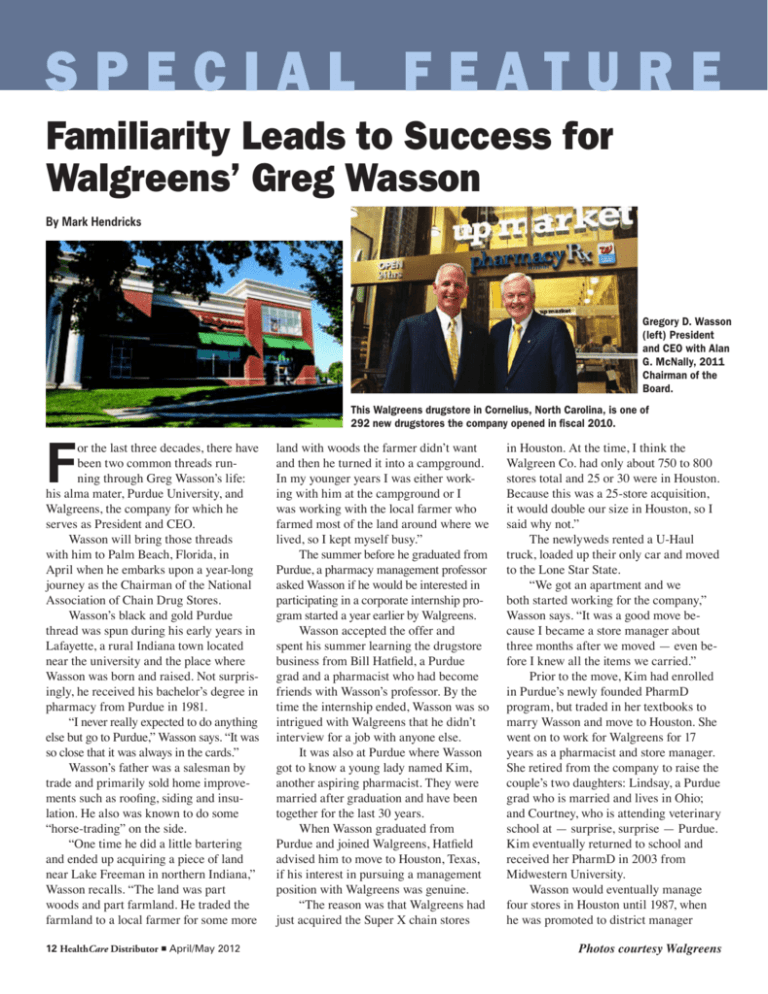
SPECIAL FEATURE Familiarity Leads to Success for Walgreens’ Greg Wasson By Mark Hendricks Gregory D. Wasson (left) President and CEO with Alan G. McNally, 2011 Chairman of the Board. F or the last three decades, there have been two common threads running through Greg Wasson’s life: his alma mater, Purdue University, and Walgreens, the company for which he serves as President and CEO. Wasson will bring those threads with him to Palm Beach, Florida, in April when he embarks upon a year-long journey as the Chairman of the National Association of Chain Drug Stores. Wasson’s black and gold Purdue thread was spun during his early years in Lafayette, a rural Indiana town located near the university and the place where Wasson was born and raised. Not surprisingly, he received his bachelor’s degree in pharmacy from Purdue in 1981. “I never really expected to do anything else but go to Purdue,” Wasson says. “It was so close that it was always in the cards.” Wasson’s father was a salesman by trade and primarily sold home improvements such as roofing, siding and insulation. He also was known to do some “horse-trading” on the side. “One time he did a little bartering and ended up acquiring a piece of land near Lake Freeman in northern Indiana,” Wasson recalls. “The land was part woods and part farmland. He traded the farmland to a local farmer for some more 12 HealthCare Distributor April/May 2012 This Walgreens drugstore in Cornelius, North Carolina, is one of 292 new drugstores the company opened in fiscal 2010. land with woods the farmer didn’t want and then he turned it into a campground. In my younger years I was either working with him at the campground or I was working with the local farmer who farmed most of the land around where we lived, so I kept myself busy.” The summer before he graduated from Purdue, a pharmacy management professor asked Wasson if he would be interested in participating in a corporate internship program started a year earlier by Walgreens. Wasson accepted the offer and spent his summer learning the drugstore business from Bill Hatfield, a Purdue grad and a pharmacist who had become friends with Wasson’s professor. By the time the internship ended, Wasson was so intrigued with Walgreens that he didn’t interview for a job with anyone else. It was also at Purdue where Wasson got to know a young lady named Kim, another aspiring pharmacist. They were married after graduation and have been together for the last 30 years. When Wasson graduated from Purdue and joined Walgreens, Hatfield advised him to move to Houston, Texas, if his interest in pursuing a management position with Walgreens was genuine. “The reason was that Walgreens had just acquired the Super X chain stores in Houston. At the time, I think the Walgreen Co. had only about 750 to 800 stores total and 25 or 30 were in Houston. Because this was a 25-store acquisition, it would double our size in Houston, so I said why not.” The newlyweds rented a U-Haul truck, loaded up their only car and moved to the Lone Star State. “We got an apartment and we both started working for the company,” Wasson says. “It was a good move because I became a store manager about three months after we moved — even before I knew all the items we carried.” Prior to the move, Kim had enrolled in Purdue’s newly founded PharmD program, but traded in her textbooks to marry Wasson and move to Houston. She went on to work for Walgreens for 17 years as a pharmacist and store manager. She retired from the company to raise the couple’s two daughters: Lindsay, a Purdue grad who is married and lives in Ohio; and Courtney, who is attending veterinary school at — surprise, surprise — Purdue. Kim eventually returned to school and received her PharmD in 2003 from Midwestern University. Wasson would eventually manage four stores in Houston until 1987, when he was promoted to district manager Photos courtesy Walgreens and transferred to Milwaukee. In 1989, he moved again, this time to manage Walgreens’ Boston district where he helped open up the company’s Rhode Island and Philadelphia-area markets. In 1996, he moved west to open the Las Vegas, Nevada, market before making the move to his present location at Walgreens’ Deerfield, Illinois, headquarters near Chicago. Positive Influences Making the climb from staff pharmacist to President and CEO is certainly a testament to Wasson’s determination, business savvy and good fortune. Along the way, he says he also benefited from the good advice and work habits displayed by others. “My biggest influence is my dad,” Wasson says without hesitation. “Growing up in Indiana, he taught us how to work hard and how to stay humble. And it’s interesting: even though he wasn’t college educated, he started that campground from scratch and it was really my first experience with business. He always said you’ve got to find something somebody wants, give it a good price and then deliver good service. And that’s the key to business. It’s pretty simple, but really it’s at the core of it.” Wasson also credits several people from his career at Walgreens with providing positive influences, including Hatfield, who is now retired. Wasson says they still keep in touch and he will always consider Hatfield to be a mentor. He says he also had a few bosses over the years that were pivotal to some of the opportunities that came his way. “One of those was my first district manager, Ed Williams, who was a very good boss,” Wasson says. “I really learned the retail business under Ed. “I also should mention a guy by the name of Jerry Karlin. At the time I interned with Bill Hatfield, Jerry was the director of pharmacy services, the head of our department.” Karlin eventually assumed responsibility for all Walgreen store operations nationwide and always kept tabs Wasson addresses more than 2,500 shareholders at Walgreen Co.’s annual meeting in January 2012. on Wasson. “One of my biggest opportunities was when he asked me to go out and open the Las Vegas market,” Wasson explains. “We had no stores there and it ended up being a great opportunity. From there, I came into the corporate office and moved up the chain of command.” As the quintessential company man, Wasson is cognizant of Walgreens’ position as an industry leader and the important role it plays in keeping community pharmacy vibrant and relevant. “I think we, as a company, have been fortunate to do that over the years, to help influence the industry and keep it strong and growing,” Wasson says. “That’s what we’re trying to do today as well.” Wasson says there’s a thread of innovation that runs through the company, going back to its earliest days as a onestore operation in 1901. For example, he pointed out: ■ In 1922, Walgreens invented the chocolate malted milkshake and served them to customers at its in-store soda fountains. ■ From the early 1940s until the 1980s, the company operated a 6,000 square-foot nonprofit drugstore in the Pentagon. All proceeds from the store went to the Pentagon Post Restaurant Council. ■ By 1953, Walgreens was the largest self-service retailer in the country, and in 1968, years before it was required by law, the company became the first major drug chain to use child-resistant containers for its prescriptions. ■ In the early 1990s, the company installed point-of-sale scanning to speed customer checkout and opened its first stores with drive-thru pharmacies. ■ In 2002, Walgreens became the first Sponsored by April/May 2012 HealthCare Distributor 13 SPECIAL FEATURE chain to offer prescription labels in multiple languages. Labels are now available in 14 languages: Arabic, Chinese, French, German, Italian, Japanese, Korean, Polish, Portuguese, Russian, Spanish, Tagalog, Vietnamese and English. Walgreens also employs a computer system known as Intercom Plus to fill prescriptions. The system links all of the chain’s 7,800-plus stores into a single network and has made the company the country’s largest private user of satellite technology and the second largest overall behind only the United States government. In addition to the company’s eager pursuit and embrace of technology and innovation, Wasson says there is a sense of family that runs throughout the organization. “The family culture was started at the very beginning by Charles Walgreen, Sr., and was continued during the first 90 to 100 years when the company was run by a Walgreen family member. Although a Walgreen no longer leads, that culture still exists today and is beneficial to the company,” Wasson explains. As the fourth non-Walgreen family member to run the company since 1999, Wasson says he has many responsibilities such as setting company strategy, managing the execution of that strategy and developing leaders who can carry the Nearly 8,000 walkers throughout Florida helped kick off the “Walk with Walgreens” campaign for customers in April 2011. This was one of several Walk events coordinated by Walgreen community leaders across the country. Walk with Walgreens is dedicated to getting people moving and educating them about the prevention and early detection of major conditions like cancer, diabetes and heart disease. 14 HealthCare Distributor April/May 2012 company into the future. None of those, Wasson says, can be accomplished unless those around him understand their roles. “Ninety percent of what I do is to communicate,” Wasson says. “I taught my daughters to take a lot of communications classes because whatever you do in life — whether it’s with your spouse or your family, and certainly as a CEO of Walgreens — it’s all about communication. I’m the chief communicator for the Walgreen Co., whether it’s internally or whether it’s externally with the public or with policy makers. When I talk to youngsters, that’s exactly what I do tell them. You have to understand that strong communication is a big part of what we all do.” In this private and sterile environment of the Walgreens specialty pharmacy in Carnegie, Pa., a pharmacy technician prepares medication and supplies for patients with complex diseases and conditions, such as multiple sclerosis, growth hormone deficiency and infertility. NACDS Involvement Wasson has been involved with NACDS for nearly seven years. He sits on the Executive Committee, and has been a member of the Board of Directors since 2007. He has taken the traditional path to becoming Board Chairman by first serving a year as Treasurer and a year as Vice Chairman. He believes NACDS truly reflects the desire and the intent of its board members and their businesses in trying to drive and influence the profession. “In my time, I’ve seen that the association under Steve Anderson’s leadership has done a terrific job in bringing focus to key issues that help the industry; and that the board has been effective in helping Steve and his team set the strategy,” Wasson maintains. “A real plus for the NACDS chairman is that the association’s strategy is that of the board’s and it’s up to Steve and his team to execute it. With that said, I think most of us are aligned with the association within our own businesses. Our strategy absolutely is to advance the role community pharmacy plays in healthcare; NACDS certainly advances that theme, so on that we are aligned.” Wasson says there are two areas he will continue to focus upon during his year as chairman. The first is working to ensure that community pharmacy receives fair reimbursement for the services it provides and for its value to patient healthcare. “Whether it’s government reimbursement or private sector reimbursement, that’s the immediate focus of the association,” Wasson emphasizes. “I think community pharmacy absolutely delivers value and needs to be recognized and reimbursed for that value.” Wasson believes the second focus area for NACDS should be helping to advance the role that community pharmacy plays as the pharmaceutical industry moves towards providing new and innovative services such as immunizations and vaccinations. “I’d like to think that Walgreens is one of the early leaders in those areas, but I think the entire industry has now stepped up and basically jumped into providing those services in a big way,” Wasson says. “I think the nation is seeing that the access community pharmacy provides to services like immunizations and vaccines are a good thing.” Wasson says medication therapy management, or MTM, will play a key role in increasing the role of community pharmacy and the reimbursement the industry receives for those roles. “The way I bucket all of this is to say Bucket A is reimbursement, and Bucket B is advancing the role community pharmacy can play and MTM is a big part of that,” Wasson explains. “We’re getting community pharmacists to really play a greater role in helping patients take their medications properly, and they need to be reimbursed for the value that role brings as a result. I’ve seen that there are probably $300 billion in annual wasted costs due to folks not taking medications properly or staying compliant. MTM addresses that.” Some people might consider serving a year as chairman for an organization like NACDS to be a distraction from their company. Wasson disagrees and says he is looking forward to his term. “I go back to what I said earlier: my role is communicating, communicating and communicating,” Wasson says. “I think being the chief communicator for Walgreens and the chief communicator for NACDS go hand-in-hand since all drug stores share many common issues and concerns. I think it’s an opportunity rather than a challenge.” Like other chairmen who have gone before him, Wasson’s involvement with the industry and NACDS won’t decline after his term ends. He admires the consistent involvement his fellow NACDS board members have demonstrated under Anderson’s leadership. “I tease Bob Loeffler about being such a good chairman this past year and that maybe he would want to stay on an additional year,” Wasson says with a laugh. “But seriously, I think the industry has really come together and understands there’s a real opportunity for us all to step up and play a much greater role — whether it’s Walgreens or Rite Aid or a regional chain.” When he takes time away from the office and boardroom, Wasson says he’s never been someone who tries to squeeze in activities like golf or tennis. He prefers to spend time near the water with his family skiing, tubing, swimming and fishing. “We have a place on a lake in southern Indiana that the girls think of as home,” Wasson reflects. “When we were moving all over the country, water activities really became their passion.” The balance between spending time with family and staying involved with business interests is something Wasson expects to continue for years to come and on into retirement. “I think my wife would say, ‘you can’t retire completely or you’ll drive me nuts,’” Wasson jokes. “But I want to strike a balance and make sure I’m able to spend time with my kids and Kim and also stay active, whether it’s on future boards or some other opportunity.” As for the impression he will leave behind when he does decide to move on to the next stage in life, Wasson says he wants people to remember him as someone truly passionate about Walgreens and who got up every morning thinking about how he could help improve the livelihoods of 250,000 employees, both economically and in how they enjoyed their jobs. “You know, when it’s all said and done, we could have the greatest locations in the country and the greatest technology, but it really comes down to having the right people and the right talent within the organization,” Wasson muses. “Fortunately throughout my years, I’ve been able to surround myself with good people and hopefully I’ve been able to help them develop and to help them advance in the company as well.” Walgreen Co.’s 2011 Board of Directors. Pictured back row, left to right: William C. Foote, Chairman of the Board, USG Corporation; Nancy M. Schlichting, President and CEO, Henry Ford Health System; Alejandro Silva, Chairman of the Board and CEO, Evans Food Group, Inc; Steven A. Davis, Chairman of the Board and CEO, Bob Evans Farms, Inc.; Mark P. Frissora, Chairman of the Board and CEO, Hertz Global Holdings, Inc. and The Hertz Corporation; and Alan G. McNally, Chairman of the Board, Walgreen Co. and Special Advisor, BMO Financial Corporation. Front Row, left to right: David Y. Schwartz, Former Partner, Arthur Andersen LLP; David J. Brailer, MD, PhD, Chairman, Health Evolution Partners; Gregory D. Wasson, President and CEO, Walgreen Co.; James A. Skinner, Vice Chairman and CEO, McDonald’s Corporation; and Ginger L. Graham. President and CEO, Two Trees Consulting, Inc. Sponsored by April/May 2012 HealthCare Distributor 15 SPECIAL FEATURE H Walgreens: America’s Premier Pharmacy ow did a neighborhood drugstore, founded in 1901 and measuring just 50 feet by 20 feet, become the pharmacy all others are measured by and one of the most respected American corporations today? It all started with Charles R. Walgreen Sr. in Dixon, Illinois. Walgreen Sr. was born near Galesburg, Illinois. The family later relocated to Dixon, — a town 60 miles north of his birthplace. It was here that Walgreen, at the age of 16, had his first experience working in a drugstore, though it was far from a positive one. Working at Horton’s Drugstore (for $4 a week) was a job he took only because of an accident that left him unable to take part in sports. While working in a local shoe factory, Walgreen accidentally cut off the top joint of his middle finger, ending his athletic competition. Were it not for the accident, Walgreen might never have become a pharmacist, business owner and phenomenally successful entrepreneur. Ironically, his initial experience working at Horton’s Walgreens is piloting a new store experience that moves beyond the traditional drugstore format to a health and daily living destination. At the core is the health center (shown here) that includes a redesigned pharmacy and, at some locations, a Take Care Clinic. In this area, patients are greeted by a health guide (right) who directs them to the services they need. The new format is being piloted at this store in Oak Park, Illinois, and other stores in Illinois, Indiana and New York City. 16 HealthCare Distributor April/May 2012 Two strong drugstore brands came together when Walgreens made the largest acquisition in its history, purchasing 258 Duane Reade stores in the New York City metropolitan area in April 2010. Beyond establishing Walgreens as a leader in the nation’s largest drugstore market, the acquisition has allowed both companies to benefit from the other’s expertise. Walgreens’ 111 years of experience as the most convenient provider of pharmacy, health and wellness services in the country has strengthened the healthcare services Duane Reade provides in its stores. Pictured is a Duane Reade store in New York City. was itself a failure. Walgreen left after just a year and a half on the job — realizing that his future lay not in Dixon, but in a far larger city — Chicago. Chicago in 1893 — the year of Walgreen’s arrival — was far from promising for a future drugstore entrepreneur. More than 1,500 drugstores already competed for business (many exceedingly successful). In a series of jobs with Chicago’s leading pharmacists, Walgreen grew increasingly knowledgeable — and increasingly dissatisfied — with what he saw as old-fashioned, complacent methods of running a drugstore. In 1901 Walgreen decided to open his own pharmacy — and as they say — the rest is history! About the Author Mark Hendricks earned his journalism degree from West Texas State University and has spent 22 years as a communicator and writer for private industry, nonprofit organizations and academic/ research institutions. He also works as a freelance writer; his stories and articles have been published by a variety of newspapers, magazines and trade publications. The following is a synopsis of important events in Walgreens history. 1901 Charles R. Walgreen Sr. purchased the Chicago drugstore where he had worked as a pharmacist — and that started the Walgreen chain. 1909 The second Walgreen store opened. 1916 Nine stores incorporated as Walgreen Co. 1926 The 100th store opened in Chicago. 1927 Walgreen Co. stock went public. 1933 Walgreens helped celebrate Chicago’s World Fair. The company opened four stores on the Century of Progress fairgrounds. These stores experimented with advanced fixture design, new lighting techniques and colors — ideas that helped modernize drugstore layout and design. 1939 Charles Walgreen Sr. died and Charles Walgreen Jr. became the company’s president. 1946 Walgreens acquired its first foreign property with the purchase of Mexican retailer Sanborn’s. In 1984, the company sold Sanborn’s. 1950 Walgreens began to build self-service instead of clerk service stores in the Midwest. 1960 W algreens entered the Puerto Rico market. Walgreens filled its 100 millionth prescription, far more than any drug chain at that time. 1969 Charles Walgreen III became the company’s president. 1975 Walgreens reached $1 billion in sales. 1981 The first Intercom computers were installed in five Walgreen pharmacies in Des Moines, Iowa. 1984 Walgreens opened its 1,000th store. 1991 The chain completed installation of point-of-sale scanning. 1992 W algreens opened its first drugstore with a drive-thru pharmacy. 1994 The 2,000th store opened in Cleveland. 1997 I ntercom Plus, Walgreens advanced computer system, completed rollout to all stores. 1999 Walgreens.com was launched. Charles Walgreen III retired; L. Daniel Jorndt becomes the first non-Walgreen named as Chairman. 2000 Walgreens reached the 3,000-store mark. 2001 Walgreens celebrated its centennial year. 2003 Walgreens reached the 4,000-store mark. 2005 Walgreens opened its 5,000th store. 2006 Walgreens acquired Happy Harry’s drugstore chain, adding 76 stores, primarily in Delaware. Walgreens began offering in-store health clinics, called Health Corner Clinics. 2007 W algreens acquired Take Care Health Systems and Option Care. Opened its first store in Hawaii in Honolulu and celebrated the opening of its 6,000th store in New Orleans. 2009 Walgreens opened its 7,000th store. 2010 W algreens acquired the Duane Reade drugstore chain in New York City, the company’s largest acquisition in its history. 2011 W algreens expands its multi-channel retail offering by acquiring drugstore.com. The company also pilots its first new “Well Experience” format stores. Sponsored by April/May 2012 HealthCare Distributor 17 SPECIAL FEATURE The Incoming NACDS Chairman at Walgreen Events Wasson with his wife, Kim, at Walgreens 7,000th store opening in Brooklyn, N.Y. The couple are enjoying hot dogs from the legendary Nathan’s Hot Dogs of nearby Coney Island. Nathan’s provided free hot dogs during the grand opening event. During the grand opening celebration of the Walgreens store in Brooklyn, N.Y., Wasson poses with store employees. Wasson visits with a Walgreens pharmacist. Wasson speaking at the 75th and State Street Walgreens in Chicago in October 2011. With him are First Lady Michelle Obama and Chicago Mayor Rahm Emanuel who visited the Walgreens that has been expanded to include produce and other basic grocery staples. 18 HealthCare Distributor April/May 2012 Photos courtesy Walgreens
